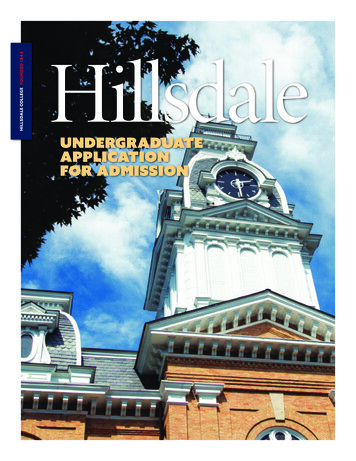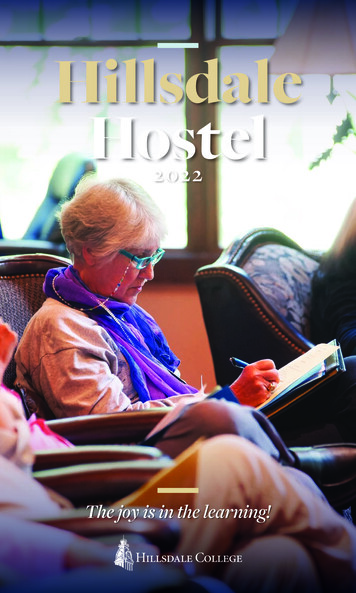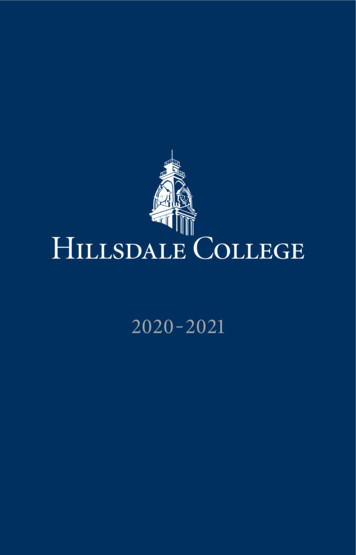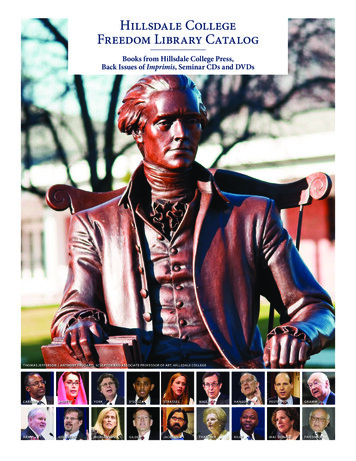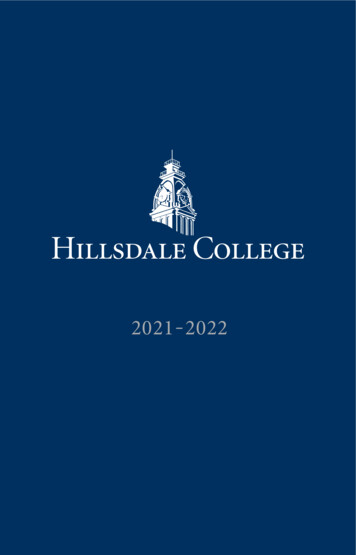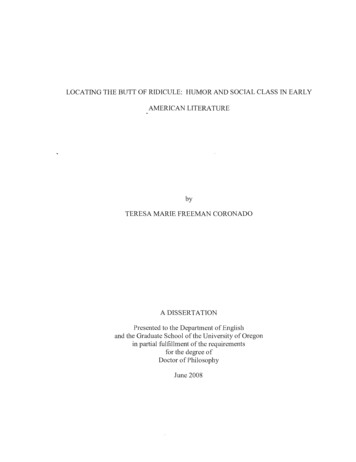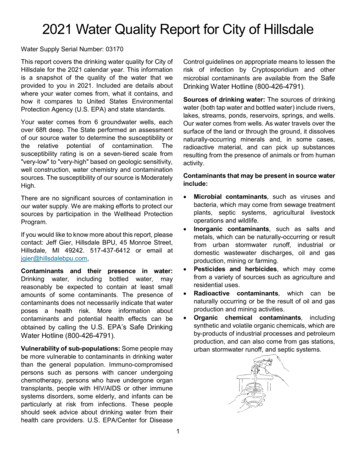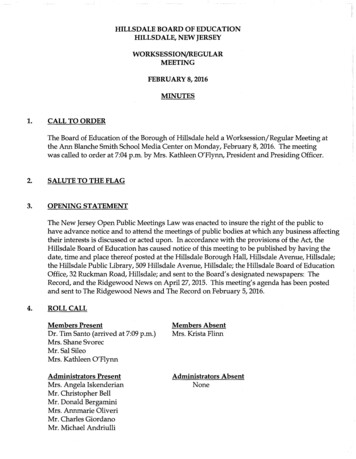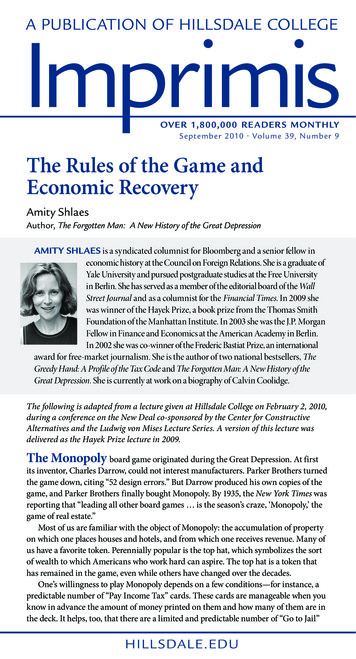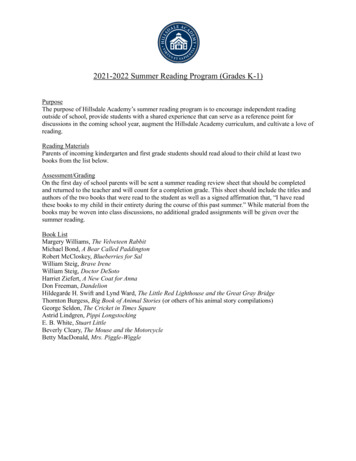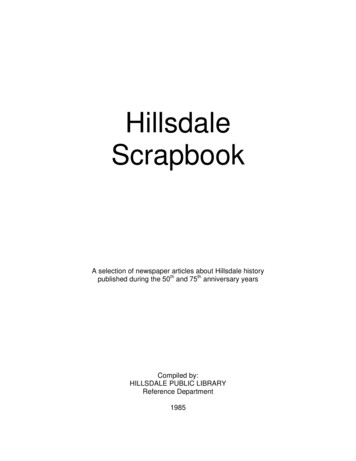
Transcription
HillsdaleScrapbookA selection of newspaper articles about Hillsdale historypublished during the 50th and 75th anniversary yearsCompiled by:HILLSDALE PUBLIC LIBRARYReference Department1985
TABLE OF CONTENTSA Brief HistoryMoments of FameFiftieth Anniversary MemoriesA Fading Past: The Clendenny FarmPersonal ReminiscencesPages 1-14Pages 15-17Pages 18-30Pages 31-35Pages 36-48
Source: Local Review March 22, 1973:14Noteworthy Dates in Hillsdale History1630 – Dutch colonists settle Bergen County.1665 – Bergen Township (now Jersey City) becomes English colony.1693 – New Barbadoes Township formed from Bergen Township.1710 – Bergen County starts to be reshaped into present area.1737 – Saddle River Township formed from New Barbadoes Township.1775 – Harrington Township formed from Saddle River TownshipSept. 28, 1778 – Baylor Massacre on Rivervale RoadJan. 30, 1840 – Washington Township formed from part of HarringtonTownship1856 – First schoolhouse built on Pascack RoadDec. 25, 1869 – First railroad train enters “Hillsdale”March 4, 1870 – Railroad opened to public at Hillsdale stationMarch 1870 – Daily mail service inaugurated1871 – Present park area in center of town donated by David P. Patterson1873 – Railroad extended to Haverstraw, NY and town becomes railroadcenterMay 3, 1874 – Hillsdale Methodist Episcopal Church organizedJune 29, 1890 – Holy Trinity Episcopal Church holds first services1898 – Magnolia Avenue School #2 openedMARCH 25, 1898 – HILLSDALE INCORPORATED AS TOWNSHIP AFTERSTATE LEGISLATURE ENABLES BREAK-AWAY FROM WASHINGTONTOWNSHIPApril 23, 1898 – Board of Education organizedMay 7, 1900 – NY & NJ Telephone Co. (now NJ Bell) granted franchise. Firsttelephone installed in home of Thomas C. Demarest on Summit Avenue(Broadway)May 6, 1901 – Township clerk authorized to purchase pair of handcuffs for useof constableApril 1902 – Hillsdale Fire Association and Ladies Auxiliary organized1902 – First macadam laid on Summit and Railroad Avenue (now Broadway)Sept. 3, 1903 – Water franchise granted Hackensack Water Co. to lay waterlines and fire hydrants1907-08 – Special town meetings authorize 45,000 to macadamize allaccepted town streets1913 – First post office building erected under Postmaster John W. KinmouthJuly 7, 1913 – First uniformed special police officer appointed1916 – Hillsdale Boy Scout Troop 1 organized by Holy Trinity Episcopal ChurchApril 17, 1917 – Hillsdale Loyal League formed in World War I1919 – Hillsdale American Legion Post 162 organized. Re-designated in 1929as General Leonard Wood Memorial Post 1621921 – New twelve room schoolhouse built (now George White School)
July 8, 1921 – Hillsdale Fire Department createdApril 24, 1923 – Borough form of government adoptedNov. 1923 – Board of Health organized1924 – Girl Scout troop organizedSept. 15, 1924 – Avolia Transportation Co. of Paterson inaugurates first busservice from Hillsdale to Paterson1925 – First assigned Road Dept. organized with Axel Gufstafson using wheelbarrow and hand toolsDec. 13, 1925 – St. John the Baptist R.C. Church dedicatedJan. 1927 – Hillsdale National Bank opens with W. Merle Hoffman as cashier(now Pascack Valley Bank & Trust Co.)Nov. 9, 1927 – Borough Planning Board appointedJuly 13, 1928 – Regular Police Dept. organizedDec. 11, 1928 – First council meeting held in present borough hall afterpurchase from Exempt Firemen’s Association in 1927April 5, 1929 – Sun dial Garden Club organized to beautify townJuly 23, 1929 – Zoning Board of Adjustment organizedApril 1931 – Shade Tree Commission formedJune 1933 – Hillsdale Businessmen’s Association organized1934 – Hillsdale Recreation Committee formedJan. 27, 1936 – Public library beings to distribute booksJune 23, 1938 – Municipal Assistance Commission organizedMay 23, 1941 – Hillsdale Defense Council formed in World War IIJuly 16, 1945 – Parks & Playgrounds Commission organized1951 – Hillsdale votes to form Pascack Valley Regional High School Districtwith Montvale, River Vale and Woodcliff Lake1951 – Municipal Garbage Collection beginsFeb. 1, 1954 – Hillsdale Ambulance Corps Begins dutySept. 1955 – Pascack Valley Regional High School opened1955 – Ann Blanche Smith School opened1964 – Meadowbrook School opened1968 – Sewer System Hookups start1972 – Work begins on new Borough Hall
Source: Local Review March 22, 1973:14HISTORY OF HILLSDALE: PART IHillsdale Got Its Name from School, StationHILLSDALE – The story of the evolution of the community known today asthe Borough of Hillsdale, with its approximately 3000 homes, businesscommunity and a population of 11,700 persons saturating most of its roughly twosquare miles of territory, is a colorful one.The delineation of the boundaries of present-day Hillsdale involved aconstant erosion of larger land divisions from 17th century colonial days to thefinal partitioning of eastern Hillsdale Township to form the Township of River Valein 1906There were two eras of great metamorphis in Hillsdale’s history – theadvent of the railroad in 1870 which literally put the few scattered farms andcountry stores near the banks of the Pascack Brook “on the map” and theopening of the George Washington Bridge in the early 1930’s.Both events brought waves of migration by the masses from the crowdedcities of New York, Paterson, and Jersey City. The new arrivals in both migratorywaves sought identical goals: land, clean air and water in a rural atmospherelocated within reasonable distance to the job markets of the large cities. The firstmigration proceeded at a leisurely pace through World War I increasing in tempoas the means of public transportation were improved by increased rail serviceand the establishment of bus routes. The second tide of migration came to a haltduring World War II but developed into an engulfing wave with the war’s end.This latter migration has today almost completely saturated Hillsdale’s availableland space.COLONIAL DAYSAlthough records are almost non-existent, it is believed that the LeniLenape Indians, members of the powerful Algonquin Nation, roamed theHackensack River valley at the time of the arrival of the first Dutch explorers andsettlers in 1630. A few Indian artifacts and the names of the Pascack andMusquapsink brooks are all that remain from the centuries of Indian occupancyof the area.The Dutch settlers from the town of Bergen in Holland transferred thename of their fatherland community to the County of Bergen in 1630 and to theVillage of Bergen in 1661. (It is now part of Jersey City) In 1665 the village andits surrounding lands became an English colony.The present State of New Jersey was divided into four counties by theBritish Crown on March 7, 1682: Essex, Middlesex, Monmouth and Bergen whichwas designated as “all the land between Hudson’s River and the HackensackRiver.” The counties were re-divided in 1710 and Bergen County then comprised
“all the land between Hudson’s River and the Pequannock and the Passaicrivers.” Bergen County took its present boundaries after the creation of PassaicCounty in 1837 and Hudson County in 1840.In 1693 the Colonial Assembly began the division of New Jersey’scounties into townships. Bergen County was divided into three townships, one ofwhich was New Barbadoes Township which included all the land between theHackensack and Passaic rivers.In 1737 Saddle River Township was carved from New Barbadoes, and in1775 just before the start of the Revolutionary War, Harrington Township wascreated from Saddle River. Thus during that war, the area which is now Hillsdalewas part of Harrington Township. The farms in the area were ravaged andplundered by the armies of both the Americans and the British and theirmercenary Hessians. The Baylor Massacre on Sept. 28, 1778 at the Hering Farmon Rivervale Road, River Vale, took place on land which was included inHillsdale from 1898 to 1906. During the war, many farmers in the area weresympathetic to the British Crown and fled to Canada: some remained and werecalled “Tories”: some spied for the British army as in the case of the RivervaleRoad farmers who betrayed Colonel Baylor.TOWNSHIPS FORMEDOn Jan. 30, 1840, Washington Township was created out of part ofHarrington Township and included: “that territory extending from New York Sateon the north to Soldier Hill Road, Oradell, on the south-between the HackensackRiver and Saddle River.” In 1894, the Boroughs of Westwood, Park Ridge,Woodcliff Lake, Montvale and Old Tappan were formed in that order. In 1898 justprior to the Spanish-American War, Washington Township had shrunk to theterritory which now constitutes the communities of Hillsdale, River Vale, Emersonand Washington Township.HILLSDALE INCORPORATEDThe state legislature was petitioned by the residents of “Hillsdale” who hadadopted the name from a school built on Pascack Road in 1856 and opened in1870 for a separation from Washington Township.The legislature granted the petition, and incorporated Hillsdale Townshipin an act passed March 25, 1898. The town comprised “all the territory betweenthe Hackensack River on the east and Orvil Township (now Ho-Ho-Kus andWaldwick) on the west – between the boroughs of Woodcliff Lake, Park Ridgeand the New York state line on the north and the borough of Westwood andimaginary line due west on the south.”Credit for sparking the movement to incorporated Hillsdale has been givento Orin S. Trall (later tax collector), John H. Riley (later freeholder), A.C. Holdrum(State Assemblyman during the period), John F. Winters, David H. Demarest,Herridon Rohrs and the following members of the first official family: SanfordBogert chairman (mayor); George Seaman, treasurer; township committeemen
Edmund Greenin; William W. Banta, clerk; Arthur J. Stever, freeholder; John A.Storms, assessor, and Ernest Koester, township counsel.MUNICIPAL SERVICESThe first election of local officials was held April 1898 in the formerHillsdale Manor House off upper Broadway, since torn down. Meetings of thetownship committee were held there until March 1899 when they were held in aroom over the Abram C. Hering store (now Pascack Board of Realtors building)at 150 Broadway until March 1901.The township was divided into three road districts early in 1898. The ratefor road work was fixed at 1.25 per day for nine hour’s work and 4.00 a day(nine hours) for one man and a team of horses. Each of the three townshipcommitteemen had charge of one road district.David Patterson had donated the land for Magnolia Avenue in 1850 and in1871 donated the land in the center of Hillsdale which is now Memorial Park.The Hillsdale Board of Education was organized April 23, 1898 with A.C.Holdrum as president and William Blauvelt as clerk. There were three schools inHillsdale in 1898: No. 1 which was the former School #1 in River Vale: No. 2 onMagnolia Avenue and No. 3 on Pascack road built in 1856. Both latter schoolshave been torn down.High school children attended schools in Park Ridge, Westwood orHackensack prior to the Pascack Valley Regional High School in 1955.The tavern of Peter A. Jersey in Pascack (Woodcliff Lake) was thedepository for mail addressed to Hillsdale on a once-a-week basis until March of1870 when the railroad entered Hillsdale. At that time it was delivered daily to thepost office established in the present Leddy Building on Hillsdale Avenue justwest of the railroad tracks. Henry G. Hering, the storekeeper, was appointed thefirst postmaster at a salary of 12 per year.Mr. Hering was one of the leading citizens of early Hillsdale for a longperiod of time. In addition to his storekeeper-postmaster duties he served asstationmaster, secretary of the railroad, township clerk, state assemblyman,under sheriff of the county from 1881 to 1886, former supervisor and taxassessor for Washington Township before Hillsdale was created, and he was acivil engineer and surveyor. Hering laid out most of the roads in Bergen Countyand owned and developed most of Hillsdale Manor.Other early postmasters were school principal W. W. Banta and John W.Kinmouth who moved it to his store on Broadway, now the Cala BrothersBuildings. At the incorporation of Hillsdale in 1898, the post office was movedback to the Leddy Building then owned by John W. Winters who becamepostmaster.POLICE AND FIREPrior to 1908, the public safety in Hillsdale was maintained by constableselected each year.
There was no organized fire-fighting unit in the community until theformation of the Hillsdale Fire Assn. in 1902.In the early days, bucket brigades of local residents fought fires afterarriving on the scene on foot or by wagons.The Town did, however, have one of the best fire alarm systems in thecounty. As the railroad car shops and roundhouse were in Hillsdale, there wereusually several engines parked in Hillsdale. The blowing of the whistles of all theengines in town signaled the discovery of a fire and could be heard for milesaround the countryside. This alarm method was used until the employment ofseveral huge iron rings at various locations in the town shortly after the turn ofthe century.THE RAILROADAs mentioned previously, the advent of the railroad effected a greatchange in the character of Hillsdale and its relation to the outside world.A charter was granted by the state on March 14, 1856 to the Hackensackand New York Railroad Company which began construction of a 21-mile line inthe spring of 1869. On Christmas Day of that year the first engine crossed whatis now Hillsdale Avenue forming a link with the Erie Railway junction south ofCarlstadt to a point just west of Hillsdale Avenue which was its temporaryterminus. When Hillsdale Station was opened for use of the public on March 4,1870 there were only six houses within half-mile radius of the site.Hillsdale residents were prominent in the organization of the pioneerrailroad. Its president was David P. Patterson: Henry G. Hering was firstsecretary: and John Alfred Storms was the agent for the first station.Equipment was primitive with wooden, open-platform cars for passengersand wood burning stoves at either end of the car for heat.The tiny railroad’s first engines were wood-burners built in Paterson. Theyremained in service until 1879. Coal burning engines were introduced in 1874,and one engine, No. 2, was adorned with the name “Hillsdale” on its sides.Shortly after 1870, the 21 miles of track were extended northward from Hillsdaleto Haverstraw, NY and was known as the Hackensack and New York ExtensionRailroad. The two lines were merged in 1873 into the New Jersey and New YorkRailroad Co. An 1879 timetable indicates five round trips per day between JerseyCity and Hillsdale and one round trip freight train. Commutation betweenHillsdale and New York (using the ferry) was 14.50 per month with one-way farecosting 75 cents. In 1896 the NY and NJ Railroad was leased to the ErieRailroad.When Hillsdale became a township in its own right in 1898 the railroad’sengine roundhouse and car shops were located in the town. Two local residentsRubin W. Jepson was superintendent of motive power, and L.B. Van Wagonenwas superintendent of the car shops. The railroad’s water tank, coaling stationand turn table were all located in Hillsdale and gave a healthy stimulant to theeconomy of the community.
The rooms over the railroad station, first used as the superintendent’soffice, later served a multitude of purposes in Hillsdale: the Fire Association andImprovement Association met there; it was the site of early services for theEpiscopal Church; local political organizations used the offices: and they laterwere converted into a real estate and insurance office.By the turn of the 20th century, the first phase of Hillsdale’s growth waswell under way, due in large part to the coming of the railroad and the prominentpart the town played in its operation.
Source: Local Review March 29, 1973:11HISTORY OF HILLSDALE: PART IITownship Of Hillsdale – The Years 1900 to 1923HILLSDALE – In the previous issue of this newspaper, the first segment ofa four-part series presenting a condensed History of Hillsdale dealt with thehistory of the community from Colonial days to the turn of the 20th century.This week’s segment will review the period from 1900, which was just twoyears after the incorporation of The Township of Hillsdale on March 25, 1898,through 1922. This period includes World War I and the entire era during whichHillsdale was governed as a township. Hillsdale adopted its present boroughform of government April 24, 1923.During the period 1900 through 1922, the growth of Hillsdale Townshipremained slow. The character of the town was still rural with farming the principaloccupation for those of its residents who did not commute to jobs in the largenearby cities of New York, Jersey City and Paterson. Local storekeepers,businessmen, and officials of the railroad were the main community leaders whoran the town.COMMUNITY SERVICESThe most noteworthy characteristic of the two decades underconsideration was the evolution of community services and utilities which aretoday taken for granted. The era saw the birth of the fire and police departments,modern roads, the coming of electric lights and the telephone, water mains andfire hydrants, new and larger schools, organizations such as the Boy Scouts andthe establishment of town parks.One of the last land alignments in the Pascack Valley took place in 1906when “all that territory in Hillsdale Township east of Demarest Avenue – CedarLane and an imaginary line due north – and the northeast part of Westwood(then known as Eastwood)” was formed into River Vale Township, leaving theboundaries of Hillsdale as they are today. Eugene E. Rich was mayor of the townin that year. From 1900 until March 1901, the township committee met in a roomover Abram C. Hering’s store on Broadway which is now the building housing theWestwood – Pascack Valley Board of Realtors. In the latter year the meetingplace was shifted to Hillsdale Manor on north Broadway (since demolished)where it remained until May 7, 1907 when meetings were held in Fireman’s Hall– the present borough hall.Railroad and Summit Avenues (now Broadway) received the firstmacadam in the town in 1902. Special elections in 1907 and 1908 authorized theissuance of a total of 45,000 in bonds to macadamize all accepted streets in thetown. The state matched the sum in aid. The importance placed upon roads atthe time is shown by the fact that 232 of the town’s 240 eligible voters in the first
election approved the bond issue. In 1910 the County Freeholders replaced theiron bridge on Broadway connecting with Westwood and a second connectionthrough Hopper Street which is now Kinderkamack Road.A public meeting April 7, 1900 petitioned the township committee toappropriate 200 to improve the present Memorial Park. In 1908 trees, plantsand flowers were planted in the park and William Hozenthaler was assigned aspark caretaker in 1921. In the same year the town purchased a flagpole for thepark, and an Honor Roll Committee was appointed to honor World War Iservicemen. A huge boulder was brought to Hillsdale on a railroad flatcar. In anattempt to transfer it to the park, the boulder fell of the transfer vehicle. Severalmeetings were held on the problem. It was decided it was too costly to attempt tomove the boulder, so it remains today where it fell just behind the present busshelter on Broadway.It was decided in 1922 to erect the present granite monument in the park.PUBLIC UTILITIES ARE INSTALLEDThe Union Electric Company was granted a franchise on May 19, 1900 toerect poles and wires for electric lights in Hillsdale due to a proposal by GenestM. Ottignon. In February 1901, the Bergen County Gas & Electric Company, anoutgrowth of the former company, was granted a franchise to lay gas mains anderect electric lights in the town. Both companies were later absorbed by thepresent Public Service Gas and Electric Company.In 1902 the sum of 2000 was voted by the town “for the electric lightningof public streets, to replace oil lamps, 32 candlepower lights to be placed onvarious streets in the township.”A franchise was granted for the NY and NJ Telephone Co. on May 7, 1900to erect poles and string telephone wires in the town. The first telephone wasinstalled in the home of Thomas C. Demarest on Broadway supervised byEdmund L. Greenin, a local township committeeman. The telephone companylater became the present-day NJ Bell Telephone Company.Mr. Greenin in 1903 was appointed by the Township Committee to securewater for Hillsdale, and on Sept. 9, 1903 a water franchise was granted to theHackensack Water Company. Two miles of water mains and 24 fire hydrantswere installed shortly thereafter.The post office in 1898 was housed in the back of a store owned by JohnF. Winters (the Leddy building) who was postmaster. In 1913, John W. Kinmouthbecame postmaster and the first wood frame post office was built.POLICE DEPT. TAKES FORMProtection of public property and law enforcement in Hillsdale wasmaintained by constables elected annually until Feb. 4, 1908 at which time AlbertW. Rawson and Christian Dies were appointed “special officers” to assist theconstables. They held office until July 1913.
Early town records show that the township clerk was authorized May 6,1901 to purchase a pair of handcuffs for the constable and a second pair on June2, 1902. The first traffic ordinance was passed June 4, 1900 “prohibiting bicycleriding on the paths upon the roadsides,” and on May 5, 1902 a speed limit ofeight miles per hour through the township was established for motorcycles, autosand bicycles. On July 2, 1906, the constables were ordered to enforce the stateauto laws.The Bergen County Detective Assn. (later to become the New JerseyRangers Detective Assn.) was organized Sept. 10, 1912 with its headquarters onSummit Avenue (Broadway), Hillsdale. At one time the group numbered 20 mencalled “pursuers.” The Rawson twins of Hillsdale Albert W. and Alpheus E.became famous as early “lawmen” in the Rangers whose trustees were allHillsdale residents.Charles E. McCleary, who owned a butcher shop on Summit Avenue, wasappointed as the first uniformed Special Police Officer July 7, 1913 at a salary of 5.00 per week. He served until the summer of 1915 and was followed byvarious other special police officers until 1921.John G. Ackerman was appointed the first recorder in May 1917 at asalary of 50.00 per year. He resigned in June and Theodore I. Haubner wasappointed to complete his three-year term.The first regular police department began to take form in January 1921when eleven special police officers were sworn in with John Hartleib namedacting chief. The town purchased badges and clubs and ordered the acting chiefto submit monthly reports to the township committee. Fred Walker took over asacting chief from H.E. Hering in 1922.FIREMEN ORGANIZEIn April 1902 the Hillsdale Fire Association was organized at a meetingheld over the railroad station. John H. Riley was elected president; J.W. Banta,recording secretary; E.F. Taylor, financial secretary; and O.S. Trall, treasurer.The association was incorporated in 1903. In March 1912, an active “Fire Dept.”was created within the association for members who wished to be active firemenwith others remaining as social members.The association was designated the “Bona-fide Official Fire Dept. of theTownship of Hillsdale” March 20, 1914 and Henry J. Werner was named the firstchief.Prior to this reorganization, the Fire Association held its first fair in August1902 with the Ladies Auxiliary and raised the money to purchase a hose reel andpump pulled on a wagon by ropes. Enough money was raised by various eventsto buy a horse drawn rig and build the fire headquarters which is now the presentborough hall in 1906. Hook & Ladder Co. #1 carried a 40-foot ladder and hose inthe rig pulled by horses rented at Calvin Gardenier’s stables on Park Street. In1907 a horse drawn hose cart was acquired. The horse hose vehicle wasreplaced by the first auto, a Mathieson, in 1914. By 1918 the town had three fire
trucks and had replaced all the horse drawn vehicles. On July 8, 1921, theassociation donated the trucks to the town.The Hillsdale Fire Patrol was formed with 35 members March 14, 1917.The men had authority to arrest violators of the law at a fire. The patrol laterbecame Chemical Co. #1.After several mergers of the different fire companies, the Hillsdale FireDept. was established by town ordinance July 8, 1921 under Chief A. Bachman.J.E. Butenschoen was chief in 1922 the year in which the newly formed eightmember Hillsdale Women’s Fire Dept. attracted the attention of three NY dailynewspapers.The local fire department gained prominence in county and state firemaniccircles from an early date. On Sept. 18, 1915, the Hillsdale firemen set a newworld’s record at the Ho-Ho-Kus Fair Grounds by laying and coupling 150 feet ofhose to a hydrant from running start in 41 seconds. In 1916, Hillsdale broke theirown record by performing the same feat in 37 seconds.The NJ and NY Volunteer Firemen’s Assn. of today was conceived inHillsdale in 1915 when Henry J. Werner was elected its first president. Thedepartment has been a member of the NJ State Firemen’s Assn. since 1916. TheHillsdale Exempt Firemen’s Assn. was organized Sept. 23, 1918 with T.C.Demarest its first president. The NJ State Exempt Firemen’s Association held itsconvention in Hillsdale in Jun 1922.The Ladies’ Auxiliary of the Hillsdale Fire Assn. was organized in 1902with Mrs. John Riley as chairman. It was reorganized in 1906 with 32 membersand Mrs. M. Clausen as president. The group assisted the firemen at many socialfunctions and carnivals and assisted the men in fund-raising projects.SCHOOLS – CHURCHESThe nucleus of what is now the George G. White School on MagnoliaAvenue was built as 12 rooms in 1921. High school students from Hillsdaleattended schools in Park Ridge and Westwood. In school elections prior to 1920it was necessary to have two ballot boxes, one for election of board membersand one for appropriations because women taxpayers were permitted to vote forappropriates but not for board members. Nominations for board members weremade from the floor with the names placed on a blackboard and the votersmaking their choice from the names listed.The Hillsdale PTA was organized in 1922 with 73 members as the resultof a petition drawn up by Mrs. Della Fox.An addition to the Hillsdale Methodist Church, then across from the streetfrom the present church, was built in 1911. William Blauvelt served as treasurerof the church school from 1904 until 1944.The parish house of Holy Trinity Episcopal Church then located on CrossStreet was used extensively during World War I by the Red Cross for makingdressings and bandages. Miss Minette Bell became the first church organist in1905.
THE BOY SCOUTSHoly Trinity Episcopal Church sponsored Hillsdale’s first Boy Scout Troopin 1916. The Rev. A.R. McWilliams was scoutmaster of Troop #1 with J. HarryHuser and Rollings Webster as assistance scoutmasters.Two additional Scout troops were sponsored in June 1920 by a group ofcitizens including Henry J. Werner, John G. Hansen and Fred D. Day. Walter M.Dwyer and Edward Singleton became scoutmasters of the new troops which laterwere known as Troops 52 and 81.Girl Scouts, Cubs and Brownies were not organized in Hillsdale untilseveral years later.LOCAL ACTIVITIES IN WORLD WAR IHillsdale’s participation in home activities during the two-year period ofWorld War I was typical of many rural communitiesThe “Hillsdale Loyal League” was recognized by the Township Committeewith 53 members April 17, 1917. The unit was led by H.I. Knickerbocker andmembers were sworn in as “special police.” An additional 20 members wereadded by the end of the year.The ground was re-designated as the “Hillsdale Home Guard” in January1918, and 25 rifles were purchased after a special election July 5, 1918. Arequest for ammunition and bayonets was denied, and the rifles were disposed ofin 1919 when the unit was disbanded.Local citizens were busy during the war years with Red Cross work, scrapdrives and other activities supporting the war effort.In 1919 returning veterans organized American Legion Post 162 withCharles Riley as commander of 10 charter members. On July 4, 1920 the firstcolors were donated to the post by Hillsdale Fire Assn.
Source: Local Review April 5, 1973HISTORY OF HILLSDALE: PART IIIBorough of Hillsdale During Years 1923-1946HILLSDALE – During the year 1922 the Civic Association, aftercanvassing the will of the residents, presented a petition to the TownshipCommittee expressing the opinion that the community had outgrown thetownship form of government.As a result, the State Legislature passed an act on March 2, 1923incorporating the Borough of Hillsdale. The residents ratified the legislature’saction in a referendum held April 24, 1923. The first Mayor and Council waselected November 12, 1923 and took office the same day with Henry J. Werneras Mayor.The principal officials in the first borough family were: Councilmen CG.G.Graf, W.W. Livengood, Frank Scott, M. Taradash, Harvey E. Hering and C.A.Lorentz; Collector-Treasurer, George W. Saul; Clerk, George M. Yates; BoroughEngineer, H.G. Hering Jr.; and Assessor, John W. Kinmouth. Garrett A. Stormsserved a long tenure as Borough Clerk from 1926 through 1950. George W.Babcock served as Borough Attorney from 1822 until his death in 1945.The first borough board to be appointed was the Board of Health formed inNovember 1923 with Ralph H. Stever as chairman. It took more than 20 years tofill out the borough’s present operating boards; the Planning Board organizedNov. 9, 1927 with W.W. Livengood, chairman; Zoning Board of Adjustment onJuly 23, 1929 with J.G. Hansen, chairman; Shade Tree Commission in April 1931with R. Lehman, chairman; Municipal Assistance Commission on June 23, 193with William B. Terry, Chairman; Parks and Playgrounds
MARCH 25, 1898 - HILLSDALE INCORPORATED AS TOWNSHIP AFTER STATE LEGISLATURE ENABLES BREAK-AWAY FROM WASHINGTON TOWNSHIP April 23, 1898 - Board of Education organized May 7, 1900 - NY & NJ Telephone Co. (now NJ Bell) granted franchise. First telephone installed in home of Thomas C. Demarest on Summit Avenue (Broadway)
